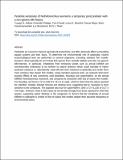| dc.description.abstract | Pesticides are crucial to improve agricultural productivity, but often adversely affect surrounding aquatic systems and their fauna. To determine the environmental risk of pesticides, routine ecotoxicological tests are performed on several organisms, including standard fish models. However, these typically do not include fish species from variable habitats and with non-generic life-histories. In particular, inhabitants from temporary ponds such as annual killifish are conventionally understood to be resilient to natural stressors which could translate to higher pesticide resistance or, alternatively, trade-off with their resistance to pesticides and render them more sensitive than classic fish models. Using standard exposure tests, we assessed short-term toxicity effects of two commonly used pesticides, Roundup and cypermethrin, on the annual killifish Nothobranchius neumanni, and compared its sensitivity with that of classic fish models. For Roundup, we found a 72 h-LC50 of 1.79 ± 0.11 mg/L, which is lower than the values reported for zebrafish, medaka, fathead minnow and rainbow trout, suggesting that N. neumanni is more sensitive to the compound. The opposite was true for cypermethrin, with a 72 h-LC50 of 0.27 ± 0.03 mg/L. However, these LC50-values do not deviate strongly from those reported for other fish species, supporting earlier findings in the congeneric N. furzeri that the sensitivity of annual killifish to pollutants is similar to that of classic fish models despite their assumed robustness to environmental stress. | en_US |

